Aug 25 2021
Published by
NYU Shanghai

A team of scientists has found an effective way to manipulate Berry curvature in a quantum material named SrRuO3. The research results, which appeared in a recent issue of internationally renowned journal PNAS, deepens our understanding of the unique electronic properties of quantum materials.
Over the past decades, researchers have found that Berry curvature is an important concept in condensed matter physics, as it plays a key role in some important physical properties of quantum materials, such as ferroelectric polarization and anomalous Hall conductivity. In this work, Hanghui Chen’s team at NYU Shanghai and Pu Yu’s team at Tsinghua University combined experimental and theoretical approaches to understand how Berry curvature of real materials could be manipulated.
The two research teams studied a prototypical ferromagnetic metal SrRuO3 to “manipulate” Berry curvature. By growing SrRuO3 films on various substrates, they applied different strains onto SrRuO3 thin films and found that the anomalous Hall conductivity exhibits an intriguing non-monotonic change with strain.
To understand this phenomenon, Professor Chen’s team performed first-principles calculations, and a realistic tight-binding model. They calculated the anomalous Hall conductivity of SrRuO3 via an integral of Berry curvature and qualitatively reproduces the experimental results. This indicates that the non-monotonic behavior of anomalous Hall conductivity arises from the Berry curvature intrinsic in the electronic band structure, while the empirical rule says that anomalous Hall conductivity is simply proportional to magnetization.
Furthermore, they also find that with the rotation of magnetization in real space, the anomalous Hall conductivity of SrRuO3 can also exhibit non-monotonic behavior, which can also be explained by the change of Berry curvature.
“We believe the findings will not only deepen our understanding of anomalous Hall effect in SrRuO3 systems but also provide an effective tuning knob to manipulate Berry curvature and related physical properties in a wide range of quantum materials,” said Chen.
Hanghui Chen is an Assistant Professor of Physics at NYU Shanghai and a member of the NYU-ECNU Institute of Physics at NYU Shanghai. Chen and Yu are the co-corresponding authors of the paper. Professor Hanghui Chen’s team includes the co-first author of this paper - Zhiwei Liu, a Ph.D. candidate from East China Normal University and a Ph.D. candidate of the NYU Shanghai-ECNU Joint Graduate Training Program (NET), as well as Hongquan Liu ’23, a Mathematics major undergraduate student at NYU Shanghai.
The research is supported by the National Natural Science Foundation of China (Grant No. 11774236), and the NYU University Research Challenge Fund.
Journal Reference:
Tian Di, Zhiwei Liu, Shengchun Shen, Zhuolu Li, Yu Zhou, Hongquan Liu, Hanghui Chen, and Pu Yu. "Manipulating Berry curvature of SrRuO3 thin films via epitaxial strain." Proceedings of the National Academy of Sciences 118, no. 18 (2021).


